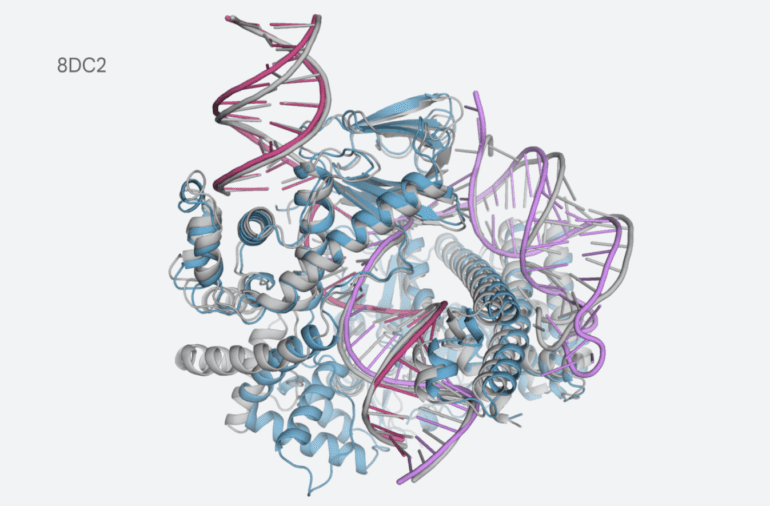TL;DR:
- DeepMind introduces AlphaFold 3, a groundbreaking AI model.
- AlphaFold 3 predicts the structures of most molecules in the Protein Data Bank.
- Isomorphic Labs applies AlphaFold 3 for drug discovery.
- The model also predicts ligand, nucleic acid, and post-translational modification structures.
- AlphaFold 3 eliminates the need for reference structures in protein-ligand interaction prediction.
- It outperforms its predecessor in protein structure prediction.
- Challenges remain in predicting RNA structures.
Main AI News:
DeepMind, the AI research lab under the umbrella of Google, made headlines nearly five years ago with the introduction of AlphaFold, an extraordinary AI system that revolutionized our ability to predict the structures of proteins within the human body. Since its inception, DeepMind has relentlessly improved this groundbreaking technology, culminating in the 2020 release of AlphaFold 2. Today, we stand on the precipice of yet another milestone in the field of molecular biology as DeepMind unveils the successor to AlphaFold 2, a game-changer for drug discovery.
The Latest Advancement: AlphaFold’s Profound Impact
In a recent announcement, DeepMind revealed that the latest iteration of AlphaFold, aptly referred to as the “new AlphaFold,” possesses the remarkable capability to generate predictions for nearly all molecules contained within the Protein Data Bank, the world’s most extensive repository of biological molecules. This astonishing achievement marks a pivotal moment in the quest to decipher the intricate molecular machinery of life.
Putting AI to Work: Isomorphic Labs and Drug Discovery
Isomorphic Labs, a spin-off of DeepMind dedicated to drug discovery, is already harnessing the power of the new AlphaFold model. Their mission? To expedite therapeutic drug design by leveraging the wealth of insights this technology can provide. By characterizing various molecular structures vital for combatting diseases, Isomorphic Labs aims to make significant strides in the realm of pharmaceuticals.
Expanding Horizons: Beyond Protein Prediction
The capabilities of the new AlphaFold extend far beyond its initial promise of protein structure prediction. DeepMind asserts that this advanced model can also accurately predict the structures of ligands—small molecules that bind to receptor proteins, orchestrating pivotal changes in cellular communication. Furthermore, it can unravel the mysteries of nucleic acids, the bearers of crucial genetic information, and decipher post-translational modifications, the chemical alterations that transpire after a protein’s inception.
Unlocking the Future of Drug Discovery
Predicting protein-ligand structures represents a groundbreaking tool in the arsenal of drug discovery. With AlphaFold’s prowess, scientists can now identify and design novel molecules with therapeutic potential. In contrast to traditional methods reliant on computer simulations known as “docking methods,” AlphaFold eliminates the need for a reference protein structure or a suggested binding position. It can predict the structures of previously uncharacterized proteins while simulating their interactions with nucleic acids and other molecules—an achievement unattainable with current docking methods.
A Quantum Leap in Performance
DeepMind’s new AlphaFold isn’t just groundbreaking; it’s a game-changer. In a statement, DeepMind highlights that its model significantly outperforms its predecessor, AlphaFold, in vital protein structure prediction challenges relevant to drug discovery, such as antibody binding. This dramatic leap in performance underscores the immense potential of AI in advancing our comprehension of the intricate molecular machinery that constitutes the human body.
Challenges Ahead
While the new AlphaFold heralds an era of unprecedented possibilities, it’s essential to acknowledge its limitations. In a comprehensive whitepaper, DeepMind and Isomorphic Labs researchers candidly discuss the system’s strengths and weaknesses. Notably, the system falls short in predicting the structures of RNA molecules, the crucial carriers of protein-building instructions within the body. However, rest assured that both DeepMind and Isomorphic Labs are diligently working to address this challenge, further cementing their commitment to transforming the landscape of molecular biology.
Conclusion:
The introduction of AlphaFold 3 represents a monumental leap in molecular modeling and drug discovery. With its ability to predict complex molecular structures and interactions, it promises to revolutionize the pharmaceutical market. The elimination of reference structures in protein-ligand interaction prediction and improved protein structure predictions open new doors for drug development, making it faster and more precise. However, addressing the challenges in predicting RNA structures will be essential for AlphaFold 3 to fully transform the market.

